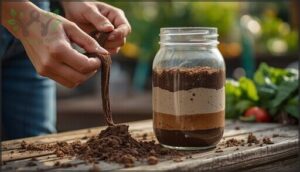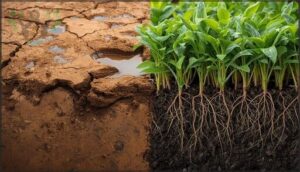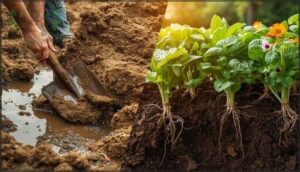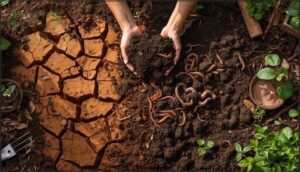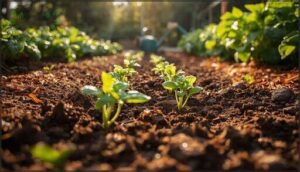This site is supported by our readers. We may earn a commission, at no cost to you, if you purchase through links.
Clay soil can break a gardener’s spirit faster than any pest or disease. You dig a hole, and it feels like chiseling concrete; you water your beds, and puddles linger for days while roots suffocate below. Those fine particles—each one smaller than 0.002 millimeters—pack together so tightly that water can’t drain, air can’t circulate, and roots struggle to push through.
Yet clay holds more nutrients than sandy or silty soils, which means you’re sitting on remarkable potential locked behind a compaction problem. The good news? You don’t need to replace your soil or surrender to raised beds forever. Strategic amendments, proper aeration techniques, and a shift in how you work the ground can transform dense clay into a thriving growing medium that sustains deep roots and bountiful harvests.
Table Of Contents
- Key Takeaways
- Identifying Clay Soil in Your Garden
- Challenges and Benefits of Clay Soil
- Essential Techniques to Improve Clay Soil
- Effective Amendments for Clay Soil
- Best Gardening Practices for Clay Soil
- Frequently Asked Questions (FAQs)
- How to make clay soil better for gardening?
- How to break up heavy clay soil naturally?
- How to turn clay back into dirt?
- Do coffee grounds help break up clay soil?
- How to turn clay soil into good garden soil?
- What is the best soil improver for clay soil?
- Do coffee grounds improve clay soil?
- How to prevent soil erosion in clay soil?
- Can clay soil support raised garden beds?
- What are the best irrigation methods for clay soil?
- Conclusion
Key Takeaways
- Clay soil’s fine particles (under 0.002 millimeters) create compaction and drainage problems, but its high cation exchange capacity (25-100 meq/100g) retains more nutrients than sandy soil, making it potentially more fertile once structural issues are addressed.
- Annual additions of 2-4 inches of organic matter like compost, combined with strategic aeration and amendments such as gypsum or biochar, transform dense clay into workable soil by improving pore space, drainage rates, and microbial activity without requiring full replacement.
- Raised beds lifting the planting zone 12-18 inches above clay dramatically improve drainage from under 0.25 to over 1.5 inches per hour, while no-till practices preserve soil structure and reduce erosion by 50-90%.
- Working clay soil when wet causes severe compaction (up to 75% particle compression from a single footstep), restricts root growth below bulk densities of 1.49 g/cm³, and undermines all improvement efforts—wait until soil crumbles easily before any cultivation.
Identifying Clay Soil in Your Garden
Before you can improve your clay soil, you need to confirm what you’re actually dealing with. Clay has distinct physical properties that set it apart from loam or sandy soils, and recognizing these traits will guide your entire approach.
Let’s walk through the telltale signs that show you’re working with clay.
Key Characteristics of Clay Soil
Clay soil stands out from other garden soils through its distinctive physical and chemical properties. You’ll recognize it by its composition of extremely fine particles—measuring less than 0.002 millimeters in diameter—which creates the characteristic dense, heavy texture. These defining traits directly influence how your garden performs:
- Clay particle size creates sticky, moldable texture when wet, often clumping on tools and forming hard clods when dry
- Soil density issues lead to compaction problems, restricting root penetration and limiting air movement through the profile
- Waterlogging effects result from poor permeability, as tiny pore spaces slow water infiltration and drainage markedly
- Nutrient retention capacity exceeds other soil types, with clay’s high surface area holding minerals effectively for plant uptake
Understanding your soil composition helps you work with clay’s strengths while addressing its structural challenges for ideal soil health.
The chemical composition of clay, including cation exchange capacity, is key for determining its suitability for various gardening applications.
Simple Soil Texture Tests
You don’t need a laboratory to determine your soil composition—simple field test techniques deliver reliable results right in your garden. The ribbon test method works by moistening a soil sample and forming a ribbon between your fingers; ribbons longer than two inches indicate clay content exceeding 40 percent.
Alternatively, jar sedimentation separates particle size distribution over 48 hours, revealing precise percentages of sand, silt, and clay for accurate soil texture analysis. Understanding soil texture classification is essential for effective garden management.
Common Signs of Compaction and Drainage Issues
Beyond texture alone, you’ll notice visible symptoms that reveal compaction and drainage problems affecting your clay soil health. Surface water pooling lasting 24–72 hours after rainfall signals infiltration rates below 0.12 inches per hour, creating anaerobic conditions that increase root rot risk by 60 percent.
Watch for these compaction symptoms:
- Persistent puddles remaining days after moderate rain
- Surface crusting within 48 hours of drying
- Stunted plant growth with yellowing leaves
- Shallow root systems confined to the top 5–10 cm
- Cracked, hardened soil surfaces limiting seedling emergence
Challenges and Benefits of Clay Soil
Clay soil can feel like a double-edged sword in your garden—it brings real challenges that test your patience, but it also offers hidden advantages you won’t find in lighter soils.
Understanding both sides helps you make smarter decisions about how to work with what you’ve got. Let’s break down the key issues and benefits you’ll encounter when gardening in clay.
Drainage and Water Retention Problems
Water drainage problems define the single greatest hurdle you’ll face with clay. Infiltration rates drop below 0.1 inch per hour in compacted clay, trapping moisture and starving roots of oxygen.
You’ll see standing water linger for 72 hours after rain, creating waterlogging issues that reduce root mass by up to 60%.
Proper drainage solutions and soil aeration become essential for maintaining healthy root zone management and preventing compaction effects.
Nutrient Holding Capacity
Nutrient retention in clay represents your secret weapon for soil fertility. The cation exchange capacity (CEC) of clay minerals ranges from 25 to 100 meq/100g, dwarfing sandy soil’s mere 1-5 meq/100g. This means your clay holds calcium, magnesium, and potassium tightly, releasing them steadily to plants.
Clay soil’s high cation exchange capacity makes it a nutrient-holding powerhouse that feeds plants steadily over time
- Clay’s negative charge attracts and stores essential plant nutrients
- Organic matter boosts CEC to 250-400 meq/100g when combined with clay
- Smectite and illite minerals provide enhanced nutrient holding over kaolinite
- Adding compost to clay soil structure creates an 80% fertility improvement within two years
Impact on Plant Root Growth
Because clay soil compacts easily, plant roots struggle to penetrate below the surface. Soil compaction at densities above 1.49 g/cm³ effectively halts root growth, forcing shallow root morphology with thicker diameters just to push through. Waterlogging compounds this by limiting aeration, prompting roots to form aerenchyma tissue for oxygen transport.
| Clay Soil Condition | Root Growth Impact |
|---|---|
| Bulk density > 1.49 g/cm³ | Root elongation ceases completely |
| Penetration resistance > 3 MPa | 51% reduction in root volume |
| Compacted clay loam | 36% decrease in root weight density |
| Waterlogged zones | Shallow lateral root systems dominate |
You’ll notice roots adapt by spreading horizontally near the surface rather than diving deep, severely limiting nutrient retention access and water uptake. Implementing aeration methods and soil amendments transforms this restrictive soil structure into a friendlier root environment.
Essential Techniques to Improve Clay Soil
You can’t just add compost to clay soil and call it a day—improving its structure requires a thoughtful combination of physical and biological methods. The techniques you choose will depend on your garden’s current condition, how much effort you’re willing to invest, and whether you’re starting fresh or working with established beds.
Let’s look at three foundational approaches that address clay soil’s core challenges: compaction, poor aeration, and restricted root growth.
Aeration Methods for Better Structure
Think of aeration as opening windows in a stuffy room—your clay soil desperately needs air circulation to support healthy root systems and microbial activity. Core aeration and mechanical tools break up dense layers, while biological methods utilize cover crops and earthworms to naturally boost soil porosity. These approaches work together to transform compacted clay into a garden environment where soil structure, drainage, and soil health steadily improve through consistent soil amendments and targeted aeration practices.
- Core aeration removes 2-4 inch soil plugs, creating essential pore space for water and oxygen penetration in compacted clay
- Mechanical tools like broadforks and plug aerators physically break up dense layers, improving soil structure more effectively than spike aerators
- Biological methods employ deep-rooted cover crops and earthworms to naturally aerate soil while boosting microbial diversity
- Annual treatment tackles clay soil’s high compaction susceptibility, with multiple passes recommended for heavily compacted areas
- Post-aeration topdressing with compost or biochar accelerates soil amendments’ effectiveness, reducing bulk density and enhancing long-term soil health
Avoiding Overworking and Compaction
Working wet clay soil is like kneading concrete—every action drives compaction deeper, crushing soil structure and choking root development. You’ll sabotage water infiltration when soil particles compress up to 75% after a single footstep on moist ground.
Wait until your clay crumbles easily in hand, then limit tilling to preserve the aeration gains you’ve worked hard to achieve through soil amendments.
Raised Beds and No-Till Approaches
Raised beds transform clay into thriving garden space by lifting your planting zone 12-18 inches above compacted ground, boosting drainage rates from under 0.25 to over 1.5 inches per hour.
No-till approaches preserve the soil structure you’ve built, cutting erosion by 50-90% while increasing water infiltration by 25-54% through intact root channels and natural pore networks.
Effective Amendments for Clay Soil
You can transform clay soil by choosing the right amendments that address its unique structure and chemistry. Different materials work in specific ways—some break apart dense particles, others feed beneficial organisms, and a few adjust the soil’s mineral balance to improve drainage and aeration.
Let’s look at the most effective amendments you can use to build healthier, more workable clay soil.
Adding Compost, Manure, and Leaf Mold
Organic matter transforms dense clay into workable garden soil, and you’ll see the best results with three proven soil amendments.
Compost increases pore space, reducing bulk density while activating microbial communities that cycle nutrients more efficiently. Manure contributes slow-release nitrogen and improves drainage by creating structural pores. Leaf mold acts like a sponge, holding moisture and loosening compacted particles while boosting earthworm populations.
Using Gypsum, Biochar, and Vermicompost
Beyond basic organic matter, specialized soil amendments can dramatically accelerate clay rehabilitation. Gypsum application breaks apart sodic clays by replacing sodium with calcium, improving friability at rates up to 2 kg per square meter. Biochar benefits include reduced bulk density and enhanced aggregate stability when you apply 20-40 tons per hectare. Vermicompost uses extend to boosting microbial activity and nutrient availability, making these three amendments powerful allies for all-encompassing soil improvement.
- Gypsum works best on saline clay soils, loosening dense particles and enhancing drainage
- Biochar stabilizes soil aggregates and increases carbon content over multiple growing seasons
- Vermicompost introduces beneficial microbes that suppress pathogens and cycle nutrients efficiently
- Combining these amendments creates synergistic effects that outperform single-amendment approaches
- Regular soil testing helps you tailor application rates to your garden’s specific clay conditions
Applying Mulches and Cover Crops
While amendments build your foundation, mulches and cover crops maintain that progress year after year. Applying 2-4 inches of organic mulch around plants reduces evaporation by up to 45%, prevents 90% of weed growth, and increases phosphorus content by 24-32%. Deep-rooted cover crops like Daikon radish create natural channels that improve soil aeration and water penetration in compacted clay.
Mulch benefits extend beyond moisture control—decomposing materials support soil microbes that improve clay structure. Cover crop roots boost nutrient cycling while naturally suppressing weeds and reducing erosion. You’ll see the best results when you combine mulching with minimal soil disturbance, avoiding work on wet clay to prevent compaction.
| Amendment Type | Primary Benefit | Application Method |
|---|---|---|
| Wood chip mulch | Reduces crusting, adds organic matter slowly | 2-4 inch layer, keep off stems |
| Straw mulch | Improves moisture retention, moderates temperature | Spread evenly around plantings |
| Daikon radish | Breaks compaction with deep taproots | Plant in fall, terminate before seed |
| Buckwheat | Solubilizes phosphorus, rapid growth | Sow densely, till before flowering |
| Mixed legume-grass | Boosts nitrogen and microbial activity | Plant spring or fall, mow periodically |
Best Gardening Practices for Clay Soil
You’ve put in the work to loosen and amend your clay soil, but the real test comes in how you manage it day to day. Smart plant selection, thoughtful watering, and strategic fertilization make the difference between fighting your soil and working with it.
Let’s look at the practical steps that keep your clay garden thriving season after season.
Choosing Plants Suited for Clay
Successful clay gardening begins with strategic plant selection, as certain species have evolved root systems and physiological adaptations that thrive in dense, nutrient-rich substrates. Select clay-tolerant plants with deep taproots—like artichokes and butterfly milkweed—to naturally improve soil structure while accessing plant nutrients effectively.
You’ll find daylilies, black-eyed Susans, and Russian sage excel in clay soil conditions, while viburnums and chokeberries develop sturdy roots that penetrate compacted layers.
Watering and Fertilization Strategies
Once you’ve chosen the right plants, fertilization and watering strategies become your tools for managing clay’s dual nature. Deep watering encourages roots to penetrate compacted layers—apply water slowly until it soaks 6 to 8 inches down without puddling.
Fertilizer timing matters: use slow-release formulas during active growth periods, and integrate soil aeration twice yearly to improve nutrient uptake and water retention in dense substrates.
Long-Term Soil Health Maintenance
Consistently maintaining clay soil requires annual additions of 2 to 4 inches of organic matter to sustain microbial balance and nutrient cycling. This organic matter retention strategy—central to effective soil amendment strategies and soil conservation—directly improves water infiltration and bolsters soil health and structure.
Combine these soil improvement techniques with mulching for soil erosion control, preserving the gains you’ve worked hard to achieve.
Frequently Asked Questions (FAQs)
How to make clay soil better for gardening?
Think of clay as a locked door—your garden needs the right key. You’ll break through by adding organic matter like compost, aerating regularly, and conditioning the soil structure with amendments such as gypsum.
How to break up heavy clay soil naturally?
You can break up heavy clay naturally by adding organic matter like compost, aged manure, or leaf mold.
Using cover crops with deep taproots effectively penetrates and loosens compacted layers.
How to turn clay back into dirt?
Rome wasn’t built in a day“—and neither is workable garden soil. Transforming compacted clay into friable dirt requires consistent soil remediation through organic matter additions like compost, promoting soil rejuvenation and improved structure over time.
Do coffee grounds help break up clay soil?
Coffee grounds can modestly improve clay soil structure when used carefully. They boost microbial activity and add organic matter, but don’t expect dramatic clay soil aeration. Apply sparingly at 1–2% by volume to avoid compaction.
How to turn clay soil into good garden soil?
How can you transform dense, unforgiving clay into a thriving garden foundation? Add 6–8 inches of organic matter like compost annually, aerate regularly, and incorporate soil amendments such as gypsum to improve soil structure and improve garden preparation.
What is the best soil improver for clay soil?
Compost stands out as the most effective soil amendment for clay, increasing water infiltration by 21% annually while boosting microbial activity.
Gypsum, biochar, and organic mulches also deliver measurable improvements in structure and drainage.
Do coffee grounds improve clay soil?
Yes, coffee grounds improve clay soil by boosting organic matter, supporting soil microbes, and improving nutrient cycling. However, excessive caffeine effects can inhibit growth, so composting grounds first ensures safer soil improvement and better compost quality.
How to prevent soil erosion in clay soil?
You can prevent soil erosion in clay soil by applying 2–4 inches of organic mulch, installing geotextile barriers on slopes, planting cover crops for root stabilization, and implementing proper water management through terracing or contour plowing.
Can clay soil support raised garden beds?
Picture a garden bed floating above stubborn clay—it’s not just possible, it works. Raised garden beds thrive on clay soil when you build them at least 6–12 inches deep, adding compost-rich fill for proper drainage and root development.
What are the best irrigation methods for clay soil?
You’ll achieve water efficiency by using drip irrigation systems with low-flow emitters spaced 30–45 cm apart, paired with smart controllers that monitor soil moisture levels and automatically adjust watering schedules to prevent runoff while promoting clay aeration and drainage.
Conclusion
The truth is, clay won’t transform overnight—but every amendment you incorporate, every careful aeration, every cover crop cycle moves you closer to soil that breathes, drains, and nourishes without resistance.
When you improve clay soil for gardening, you’re not just fixing a problem; you’re unlocking nutrient reserves that sandy soils can’t match.
Stay patient, work with the seasons, and watch your garden reward persistence with deeper roots and stronger yields.
- https://books.tenthacrefarm.com/the-permaculture-inspired-vegetable-garden/?utm_source=taf&utm_campaign=TPIVG2&utm_medium=banner1-link
- https://learningandyearning.com/fall-leaves-a-valuable-soil-builder
- https://pickyourown.org/countyextensionagentoffices.htm
- https://rodaleinstitute.org/science/articles/choosing-the-best-cover-crops-for-your-organic-no-till-vegetable-system/
- https://www.sciencedirect.com/topics/agricultural-and-biological-sciences/clay-soil



